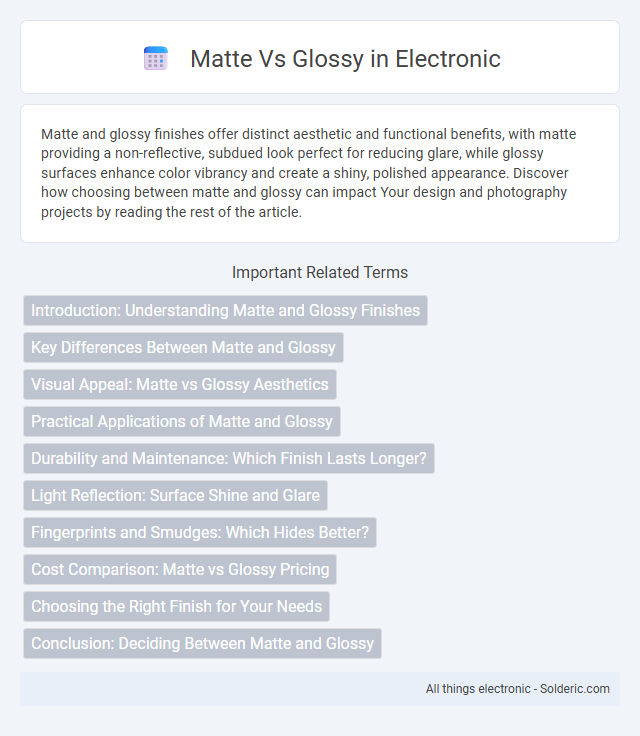Matte and glossy finishes offer distinct aesthetic and functional benefits, with matte providing a non-reflective, subdued look perfect for reducing glare, while glossy surfaces enhance color vibrancy and create a shiny, polished appearance. Discover how choosing between matte and glossy can impact Your design and photography projects by reading the rest of the article.
Comparison Table
| Feature | Matte Finish | Glossy Finish |
|---|---|---|
| Appearance | Non-reflective, smooth, muted colors | Shiny, reflective, vibrant colors |
| Fingerprint Resistance | High resistance, less visible fingerprints | Low resistance, fingerprints visible |
| Glare | Minimal glare, easy to view under bright light | High glare, can cause reflections |
| Durability | Resistant to scratches and smudges | Prone to scratches and smudges |
| Color Accuracy | Natural and subtle tones | Enhanced, saturated colors |
| Best Use | Professional documents, art prints, photo albums | Photography, advertisements, vibrant displays |
| Cleaning | Easy to clean without streaks | Requires careful cleaning to avoid streaks |
Introduction: Understanding Matte and Glossy Finishes
Matte and glossy finishes offer distinct visual and tactile qualities that affect the appearance and durability of surfaces. Matte finishes provide a non-reflective, smooth texture that minimizes glare and fingerprints, making them ideal for subtle, elegant looks. Glossy finishes feature a shiny, reflective surface that enhances color vibrancy and detail, perfect for making images and objects appear more vivid and striking.
Key Differences Between Matte and Glossy
Matte and glossy finishes differ primarily in their surface reflection and texture, with matte offering a non-reflective, smooth finish that reduces glare and fingerprints. Glossy surfaces provide a shiny, reflective quality that enhances color vibrancy and sharpness, making images stand out more vividly. Your choice depends on whether you prioritize glare reduction and subtlety (matte) or brightness and impact (glossy) in your visuals.
Visual Appeal: Matte vs Glossy Aesthetics
Matte finishes offer a smooth, non-reflective surface that reduces glare and provides a sophisticated, understated look, enhancing the clarity of images or text without distractions. Glossy surfaces deliver vibrant colors and sharp contrast, making visuals appear more dynamic and eye-catching with a shiny, reflective quality. Choosing between matte and glossy depends on your aesthetic preference and the environment where the visual will be displayed to maximize impact and readability.
Practical Applications of Matte and Glossy
Matte finishes are ideal for reducing glare and fingerprints on screens, making them perfect for office environments and product packaging where readability is crucial. Glossy surfaces are commonly used in photography and promotional materials to enhance color vibrancy and visual impact, capturing attention in advertisements and displays. Your choice between matte and glossy should consider the lighting conditions and the desired aesthetic effect to ensure optimal presentation.
Durability and Maintenance: Which Finish Lasts Longer?
Matte finishes typically resist scratches, fingerprints, and glare better than glossy surfaces, making them more durable for everyday use. Glossy finishes, while visually striking with their reflective shine, tend to show smudges and scratches more easily and require frequent cleaning to maintain their appearance. Choosing matte can reduce maintenance efforts and keep your surfaces looking cleaner for longer periods.
Light Reflection: Surface Shine and Glare
Matte surfaces diffuse light, minimizing shine and glare for a soft, non-reflective appearance, making them ideal for reducing distractions and enhancing readability. Glossy finishes reflect light sharply, creating a bright, polished surface with noticeable shine and glare that can amplify colors and contrast. Understanding the interaction between surface texture and light reflection is crucial for selecting the right finish based on visual impact and environmental lighting conditions.
Fingerprints and Smudges: Which Hides Better?
Matte finishes excel at hiding fingerprints and smudges compared to glossy surfaces, which tend to show marks more prominently due to their reflective nature. If you want your devices or surfaces to look cleaner for longer periods without constant wiping, matte textures offer a practical advantage. Your daily use and environmental factors play a role, but matte's texture diffuses light, minimizing visible smudges effectively.
Cost Comparison: Matte vs Glossy Pricing
Matte finishes generally cost more than glossy options due to their specialized coating processes and higher material requirements. Glossy surfaces, benefiting from simpler manufacturing techniques, tend to be more budget-friendly while offering vibrant color reproduction. Choosing between matte and glossy often depends on balancing budget constraints with desired aesthetic and functional qualities.
Choosing the Right Finish for Your Needs
Matte finishes offer a non-reflective surface that reduces glare and hides fingerprints, making them ideal for artwork, photography, and modern interiors. Glossy finishes provide a shiny, reflective surface that enhances colors and details, perfect for vibrant visuals and high-traffic areas. Selecting between matte and glossy depends on the desired aesthetic, lighting conditions, and maintenance preferences specific to your project.
Conclusion: Deciding Between Matte and Glossy
Choosing between matte and glossy finishes depends on the desired visual effect and practical needs; matte provides a non-reflective, smooth surface ideal for reducing glare and fingerprints, while glossy offers vibrant colors and sharp details with a shiny appearance. Matte finishes suit professional settings and products requiring subtlety, whereas glossy is preferred for eye-catching displays and photographs that benefit from enhanced contrast. Consider lighting conditions, usage environment, and aesthetic preferences to make an informed decision.
Matte vs Glossy Infographic

 solderic.com
solderic.com